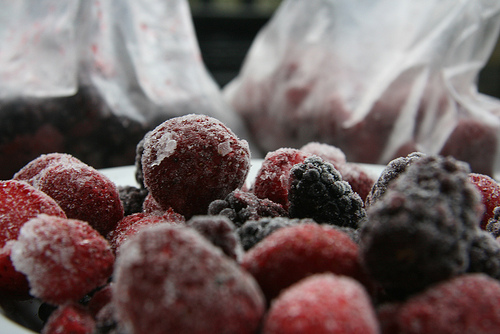Freezers Full of Summer

Straight from the freezer to students’ lunch trays, schools are finding ways to serve local berries all year long. Photo credit: Deborah Kane
It’s February and, as tends to happen every year, I’m starting to run low on frozen berries. It seems the hours upon hours I spent this summer freezing the season’s bounty weren’t enough to satisfy my family’s endless demand for berry smoothies. Every year I vow to put more berries away for use in the winter. I suspect this summer will be no exception; I’ll take the pledge again.
It turns out I’m not the only one freezing local foods for later use. A recent report by the Institute for Agriculture and Trade Policy (IATP) shows that – at least in Minnesota where the summers are short and the winters long – more and more schools are freezing foods at their peak of production for later use in the school cafeteria.
The report, Frozen Local: Strategies for Freezing Locally Grown Produce for the K-12 Marketplace, shows that freezing locally grown produce on-site in K-12 facilities can be a positive and affordable strategy for interested schools as long as appropriate crops are used and freezing activities are tailored effectively to the school’s operating environment. The Institute for Agriculture and Trade Policy explored several potential avenues for freezing locally and regionally grown produce on a small-to-medium scale for the K-12 marketplace: schools freezing on-site in their own kitchen facilities; mobile freezing units; commercial kitchens and small freezing enterprises; and co-pack relationships with existing freezing companies that could potentially serve the K-12 market.

Freezing berries provides a taste of summer no matter what the season. Schools are increasingly freezing summer’s bounty for later use in the cafeteria. Photo credit: Deborah Kane
Every year, through our Farm to School Grant Program, USDA awards up to $5 million in grants to help schools connect with local producers and teach kids where their food comes from. These funds support activities ranging from training, planning, and developing partnerships, to purchasing equipment, planting school gardens, and organizing field trips. The Institute for Agriculture and Trade Policy recently received a USDA Farm to School grant to work with school districts in the Upper Midwest on buying more regionally grown foods. Options like regionally grown bean products, lentils, gluten-free grains and frozen produce are all on the list for further exploration.
Here’s to hoping I freeze enough berries this summer to last all winter. And here’s to hoping that school districts across the country increasingly do the same. I’ll be thinking of those school food service directors digging deep into their walk-in freezers every time I grab a bag of my own.
Editor’s Note: The request for applications for USDA’s FY 2014 Farm to School Grant Program was recently released. Proposals are due April 24, 2013. For more information, and a schedule of upcoming webinars, see the USDA Farm to School website.
Thinking about freezing local foods in your own home? Check out our fact sheet on Freezing and Food Safety.

Hi Deborah, thanks for the blog post. Interesting idea for getting more local produce into our schools. Wanted to share a great way to eat your frozen berries in case you’ve not discovered it: A double layer of frozen berries (blueberries are my favorite) in a reused medium sized deli container with about 1/2-3/4 cup of fat free yogurt on top. In about 20-30 minutes the berries will have created a partially frozen yogurt treat! Very tasty.